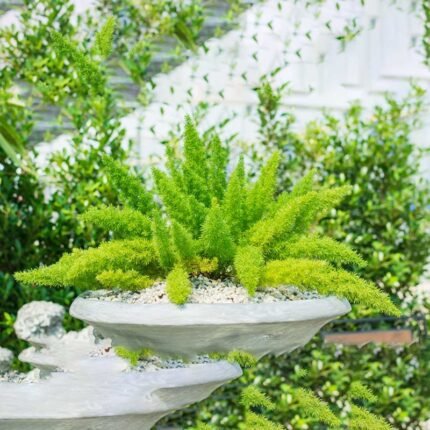AGAVE
Agave plants are succulents with large leaves that end in pointy tips. Large, stiff specimens can grow to 10 feet or more in height and width, and smaller species can be dish-sized. A few agave species have soft leaves and no spines. Agave grows best in rocky, sandy, well-drained soil in full sun. Fertilizer can encourage agave to bloom, which is not recommended because the plant only blooms once, then dies.
ASPARAGUS SPRENGERI
Normally planted in the spring, the fast-growing asparagus fern has a lot of good qualities, but it comes with some important cautions. In warm, humid climates, asparagus ferns can spread rapidly when planted outdoors—to the point of serious invasiveness. Neither plant is a fern, but instead, they are warm-weather perennials closely related to the common edible garden asparagus.
BARREL CACTUS
The aptly named golden barrel cactus or golden ball (Echinocactus grusonii) rarely grows in its native habitat. It is sometimes used in the outdoor garden in dry climates where temperatures never fall below 4 degrees Celsius. It’s called a barrel cactus because, as the name implies, they are almost perfectly round when juvenile. They are beautiful, with evenly spaced rows of spines on their deeply ribbed lobes. As they grow, it’s not uncommon for them to stretch out, so they are more oval than circular.
BASIL PLANT
Basil plants are one of the most popular herbs to grow and also one of the easiest. Sweet basil (Ocimum basilicum) is a member of the mint family. It is closely identified with Italian cooking, although it is originally from India. The extremely aromatic leaves also have a delightful variety of flavors, from the slightly lemony-mint of sweet basil to cinnamon and licorice. Leaf colors span from rich green to deep purple, with smooth or crinkled leaves. The flowers are insignificant but very popular with bees.
BISMARCK PALM
The Bismarck Palm, scientifically known as Bismarckia Nobilis, is a stunning and majestic palm tree that is native to Madagascar. It is a slow-growing palm that can reach a height of 30 feet and a width of 20 feet, making it a perfect choice for large landscapes and gardens. The Bismarck Palm has a single, thick trunk that is covered in a grayish-brown bark, and it is topped with a crown of large, fan-shaped leaves that can grow up to 10 feet in diameter. The leaves are a beautiful silvery-blue color, which makes them stand out in any landscape. The Bismarck Palm is a hardy plant that can tolerate a wide range of soil types and temperatures, making it an ideal choice for tropical and subtropical regions. It requires full sun exposure to thrive and should be watered regularly during the growing season. The Bismarck Palm is also resistant to most pests and diseases.
BOGAINVILLEA
Botanically, the plants are classified as woody vines, although they often behave more like shrubs. In fact, they can easily be trained to grow as shrubs . The foliage of these tropical flowers is usually evergreen in warm climates, but their leaves will sometimes drop if watering has been insufficient. These vines can attain a height and spread of 15-40 feet and contain thorns. What appears to be the flower on bougainvillea plants is actually a foliar structure referred to as a “bract.” The flower, technically, is much smaller and not nearly as eye-catching.
BUCIDA
Bucida buceras, Though commonly called ‘black olive tree’, this native of the upper Florida Keys is not the edible olive we know and love but does produce a small, black seed capsule. Black olive is a 40 to 50-foot-tall evergreen tree with a smooth trunk holding up strong, wind-resistant branches, forming a pyramidal shape when young but developing a very dense, full, oval to rounded crown with age. Sometimes the top of the crown will flatten with age, and the tree grows horizontally. The lush, dark bluish-green, leathery leaves are two to four inches long and clustered at branch tips, sometimes mixed with the 0.5 to 1.5-inch-long spines found along the branches.
CEREUS PERUVIANUS
Cereus Peruvianus, the Peruvian cactus, is a large, erect, thorny columnar cactus found in South America. It is also known as giant club cactus, hedge cactus, cadushi, and kayush. Cereus repandus is grown mostly as an ornamental plant. The Peruvian apple cactus thrives on bright light and sunlight, although direct sun when blazing hot is best avoided, when first introduced to direct sun. It’s advisable to water this plant more often within the summer and much less, winter time. Like other desert-type cacti, their natural habitat is dry and they store water within the stems. Water this plant when the soil begins drying out, throughout spring and late summer. In late summer reduce watering until the next spring and allow the soil to be fairly dry.






















